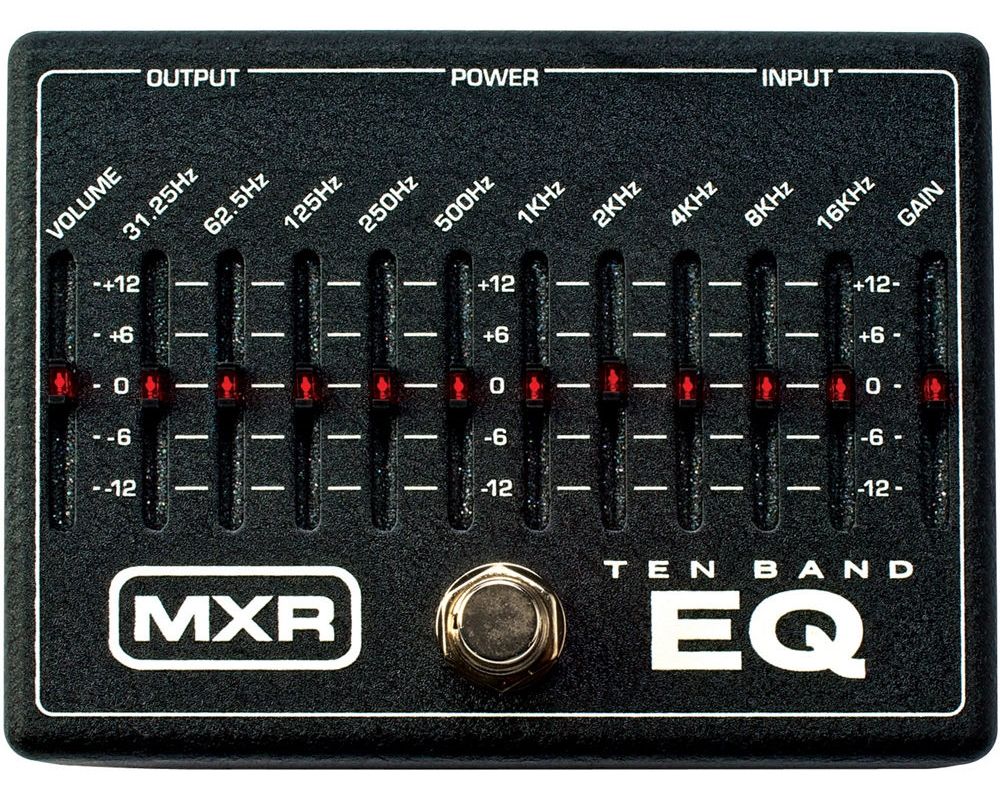Contents
Overall, MXR 10-Band EQ is a solid pedal but you can only put it to good use if you completely grasp MXR 10-Band EQ settings. You have a hard time getting MXR 10-Band EQ to do what you want and could use some help? Then it’s suggested that you spare a bit of your time to check out my article. Down below is everything you must know before tuning the settings of MXR 10-Band EQ for genres such as rock, metal, funk, jazz, …
A Beginner’s Guide
In the beginning, connect your instrument to the input jack of the EQ pedal. Next, connect the output jack of MXR 10 to the amplifier of other effect pedals in your signal chain. After you finish, proceed to connect your pedal to the appropriate 18-volt adapter and power it up. The moment the pedal is up, you can start manipulating its setting in earnest.
MXR 10-band EQ comprises 10 sliders that represent specific frequency bands so feel free to use each slider to boost/cut the corresponding frequency range. For your information, the sliders on the far left of the pedal control the bass and response of your instrument. Meanwhile, the sliders on the far right of the pedal control the treble. Last but not least, the sliders in the middle of the pedal control midrange frequencies.
The process is no-nonsense: slide the corresponding slider upward/downward to boost/cut a frequency. Of course, you should strive for a balance since modifying one frequency excessively may result in harsh and unnatural sounds.
Note: You can use the EQ paddle to cut some frequencies and remove unwanted tonal traits to improve your music in times of need.
Tuning MXR 10-Band EQ: Insights
Classic Rock
You may achieve a classic rock tone by boosting lower frequencies to get more bass and cutting high frequencies to reduce treble. You can start by boosting to 100 Hz, 250 Hz, and 400 Hz by 3-6 dB and cut to 1.6 kHz and 3.2 kHz by around 3 dB. Shift the individual sliders and try several variations until you get the best sound for your taste. Depending on the situation, don’t hesitate to change the pedal’s position in your signal chain.
Metal
You must boost the midrange frequencies and cut the lows as well as highs for a more distinct sound. Start by boosting the mids to about 250 Hz and 400 Hz by around 6 dB then cut the highs and lows to 62.5 Hz and 16 kHz by around 3 dB. Metal is a broad genre and a wide range of settings exists to play with the sliders until you achieve the tone you want.
Funk And Jazz
Boosting highs and mid frequencies while cutting lows will net you the best sound for funk. Take the highs and mids to 1.6 kHz and 3.2 kHz by around 6 dB and the low frequencies at 62.5 Hz by around 3 dB for a basic funk tone. Since jazz has a more balanced EQ than funk, it’s wise to boost to 400 Hz and 1.6 kHz by around 3 dB and cut to 62.5 Hz and 16 kHz by around 3 dB. Once again, you may adjust the settings of the pedal to get the perfect profile.
Note: Keep all the sliders at the same level at about 12 o’clock if you want to give your bass or guitar a clean boost. That is going to boost the overall signal without adding emphasis to any specific frequencies. You also have the option of adjusting the output level knob to change the overall volume of the output so it has a more significant effect on the other pedals.
Tips And Tricks
- Always start with basic settings: Ensure all sliders have been set to the same level at about 12 o’clock before you begin altering the frequencies. By doing so, you should be able to have a neutral starting point from which to operate. Needless to say, it’s easy to get carried away with EQ tweaks but even minor alterations can make a tremendous difference. Instead of applying big changes, make modest adjustments to particular frequencies and attentively listen to how they alter your tone.
- Follow your creative instincts: Don’t forget that EQ is a personal preference and what sounds nice to one person may not sound good to another. Rather than adhere to rules or norms, use your ears to establish your preferred tone. Noteworthily, the output level knob is used to adjust the overall volume of the pedal’s output. Exercise caution as you tweak the knob to match the strength of your clean signal or boost your signal if you want to.
- Give the instrument some thought: To put it plainly, your instrument also determines the kind of tone your pedal produces in use. Instruments have varying tonal characteristics so take them into account while tweaking the settings. Experiment with MXR 10 Band EQ in different orders of your signal chain.

Hi music fan! I am Jeff. Hope that you enjoy some stuff I shared here in my personal blog.
About myself, Currently I am in charging as Artist Manager/Music Supervisor at 72 Music Management. I did managed album to Grammy Award in 2017 with 7 Nominations from 2014-2020 and had the opportunities to work with : A.J. Croce, Blind Boys of Alabama, Bobby Rush, Dom Flemons, Dustbowl Revival, Sarah Grace
Governor of the Memphis Chapter of The Recording Academy is one of a award that I am lucky to achieved.

